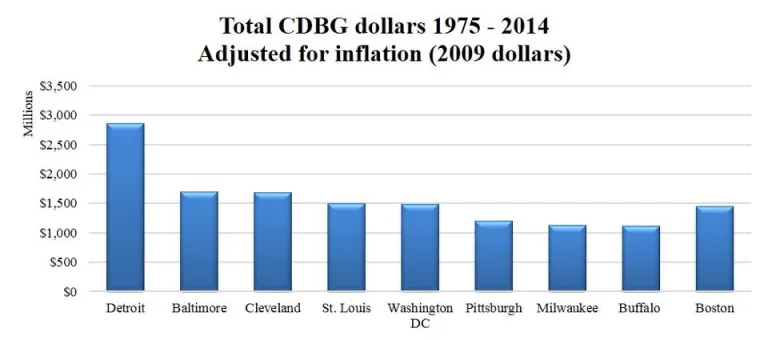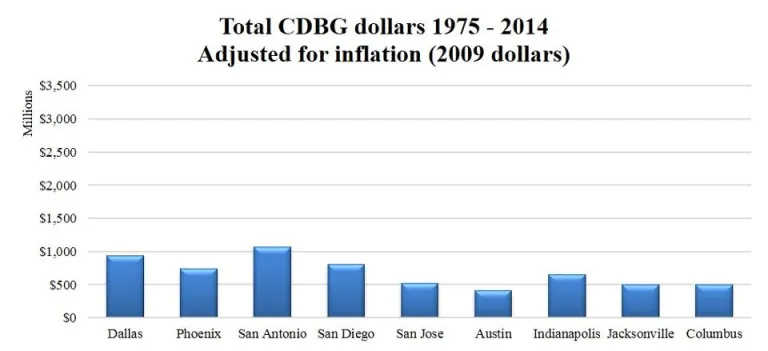- | Housing Housing
- | Expert Commentary Expert Commentary
- |
Local Governments Can Lay the Foundation for Economic Prosperity but They Can't Build It
Money alone will not generate economic development in America’s struggling cities. Local rules, regulations and institutions can support or hinder top-down, hydraulic economic development efforts and ignoring this reality is a big reason why many such efforts fail.
A few weeks ago the Mercatus Center released a study by my colleague Eileen Norcross and I about Scranton, Pennsylvania. In the study we analyze Scranton’s economic decline, compare its current economic situation to other nearby cities and discuss its fiscal situation, which has been in disarray for over two decades.
At the end we make some policy suggestions that could help Scranton become a better place to live and work. These include reducing taxes that discourage productive activity, simplifying regulations, selling or otherwise privatizing city assets that are not necessary for providing core services and fully funding their drastically underfunded municipal pension plans.
To some people these mundane, somewhat obvious recommendations might be unsatisfying: don’t spend more money than you take in, don’t make it too difficult to start a business and keep your financial promises. Moreover, we don’t even promise that they will work!
But despite their simplicity and uncertain efficacy, these recommendations are useful. In fact, they are useful because of their simplicity. As William Bowen and Chang-Shik Song of Cleveland State University note, “[t]he knowledge required to make sound decisions about how to improve prosperity for an entire urban economic system exists only in widely disbursed form among all of the members of that system, each of whom knows his or her own situation better than does anyone else.”
More specific policy recommendations that attract a lot of attention—build a stadium, subsidize a particular business or area, make the city more walkable or refurbish the downtown—are unsuccessful more often than not. Such top-down policies often ignore the reality on the ground and interfere with the unique plans of the thousands of residents who call the city home.
The ineffectiveness of top-down efforts
For example, economic incentive programs such as the New Markets Tax Credit program or Tax Increment Financing alter a city’s tax policy via company-specific tax abatements, exclusions, rates and credits. These are often referred to as tax expenditures and they create distortions in the local economy that favor certain business or industries. There is also no evidence that they consistently improve local economies.
Ohio, my home state, has several shrinking cities—Cleveland, Dayton, Youngstown and others—within its borders and many of them have used tax expenditures in an effort to revitalize their local economies. But a study that analyzed the use of tax expenditures in Ohio concludes that there is little evidence that tax expenditure programs have resulted in any meaningful economic development in the state.
Building stadiums is just as unlikely to yield results. In a summary of the relevant research about the economics of sports facilities, the authors found “virtually no evidence of economic development benefits from sports teams or stadiums”. Other research finds a possible negative impact on local economic development from the subsidization of sports stadiums. Another study released by the Mercatus Center last year also finds that professional sports teams do not consistently benefit local economies and in some cases may actually harm them.
The hydraulic approach to economic development
It really shouldn’t be surprising that such urban development efforts rarely yield results. Foreign economic development has been just as unsuccessful as urban economic development despite hundreds of billions of dollars and the attention of some of the world’s greatest minds.
For decades the Harrod-Domar model of economic growth dominated the landscape of international economic development. That model emphasizes savings and the role of capital investment in the creation of viable economic development and it produced what Nobel Prize winner Angus Deaton calls the hydraulic approach to economic development – if money flows in at one end it must flow out the other.
The hydraulic approach portrays economic development as a plumbing or engineering problem. The basic idea is that certain tangible things are needed for a country to be successful, the cost of these things can be summed, the money can be procured, and the projects can be completed for the specified cost. In short: money in, projects out. Once the projects are complete, robust economic development will occur.
After decades of direct foreign aid in the spirit of the hydraulic approach, it became obvious to most that money alone would not lead to robust economic development in foreign countries. In the 1980s and 90s New Institutional economics started changing the way economists and policy makers thought about economic development, placing a heavier emphasis on institutions or “the rules of the game”. This research emphasized that if a country’s institutions create bad incentives—often due to a lack of rule of law and property rights—then no amount of investment will generate economic development.
But while some in the foreign development world have recognized the hydraulic approach’s flaws, urban development still largely follows this model. For example, the federal Community Development Block Grant (CDBG) program disperses federal money to local governments. The funds can be used on a variety of projects provided that they further one of the three national objectives of the program: benefitting low and moderate income persons, addressing slums or blight, or meeting an urgent community development need.
The CDBG program is the largest source of federal funds for urban improvement initiatives, which means that if federal funds can lead to robust urban development we would expect to find an effect from this program. Yet as with other development efforts that assumed money would fix things, the results have been underwhelming.
The figure to the left depicts the total CDBG dollars apportioned to nine different cities that were each in the top 15 US cities by total population in 1950. 
From 1975 to 2014 each of these cities received at least $1 billion dollars. Five cities received at least $1.5 billion and Detroit received nearly $3 billion. Yet despite this extensive investment in local economic development, all of these cities experienced substantial population loss during the latter 20th century. By 2013, none of these cities were in the top 15 by population.
Now compare those cities to the cities in the second figure to the left, which depicts the total amount of CDBG funds apportioned to the nine cities that took the place of the previous nine cities in the top 15 by total population as of 2013. None of the cities depicted received $1.5 billion and only one—San Antonio—received at least $1 billion. 
So despite the substantial disparity in CDBG funds received by the two group of cities, the latter group prospered while the former group withered. While this is not an all-else-equal analysis and does not prove that the hydraulic approach to urban development doesn’t work, it certainly doesn’t support it.
Conclusion
Money alone will not generate economic development in America’s struggling cities. Local rules, regulations and institutions can support or hinder top-down, hydraulic economic development efforts and ignoring this reality is a big reason why many such efforts fail.
Detroit is a prime example. Many point to the decline of the American automobile industry as a significant factor in its decades-long decline. And while that was certainly part of it, Detroit also had a corrupt government that routinely doled out favors to well-connected businesses and obstructed the projects of others. This type of political and business climate is also a reason for the city’s decline and the billions of dollars of federal money didn’t address this problem.
In light of the lack of supporting evidence for the most common top-down efforts, recommendations such as simplifying taxes and regulations and keeping spending under control become less mundane: adhering to them is the exception, not the norm.
Low taxes that don’t discourage production, simple and transparent regulations that apply to all firms without burdening them with excessive costs and the efficient provision of core government services creates an environment suitable for economic growth. Creating such an environment is the best thing local officials can do for their cities.